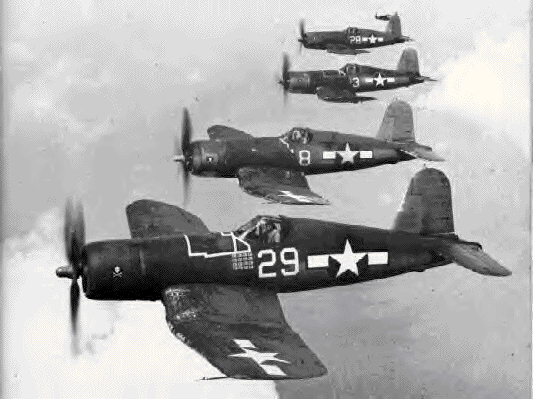Classic Combat Aircraft | home
Vought F4U Corsair

Known as the best carrier-based fighter to be used operationally in WWII, the Corsair has become legendary. Known to the Japanese as "Whistling Death", the Corsair was famous for its gull-wings and powerful punch . The Corsair was the first U.S. single-engined fighter to exceed 400 m.p.h., and had much better performance than the outdated F4F Wildcat , which was the current top-of-the-line Navy fighter when the Corsair was introduced. Unfortunately, due to its very long nose (which limited visibility, especially during take-offs and landings), it was believed by the Navy "brass" to be unsuitable for carrier operations. Typically, when the Navy had an aircraft that it did not want, it gave them to the Marines. This is what happened to the Corsairs, as they were restricted to land bases. The Marines were happy to replace their old Wildcats with this hot new fighter, and soon showed everyone what the Corsair was capable of. Pappy Boyington and his Black Sheep Squadron was one of many who used the Corsair's abilities to their advantage. Later in the war it was proven that the Corsairs could operate safely off of carriers, and the "bent-wing birds" were used very successfully in helping to wart the kamikaze attacks in the war's final months. Demand for the Corsairs was such that they were also produced by Brewster and Goodyear.

Type: Fighter
Crew: 1 (Pilot)
Armament: six .50 cal machine guns
four 2Omm cannons (later versions)
Specifications:
Length: 33' 8" (10.26 m)
Height: 14' 9" (4.50 m)
Wingspan: 41' (12.5 m)
Weight: 14670 lbs (6653 kg)
Engine: 1
Powerplant: Pratt & Whitney R-2800-18W
2100 hp

Performance:
Range: 1005 miles
Speed: 446 mph
Ceiling: 41500 ft
Click here for more F4U pictures.

(EAA)
An F4U Corsair crashes and burns on takeoff roll after it clips an
F8F-1 Bearcat on Thursday, July 29, 1999. The pilot survived!